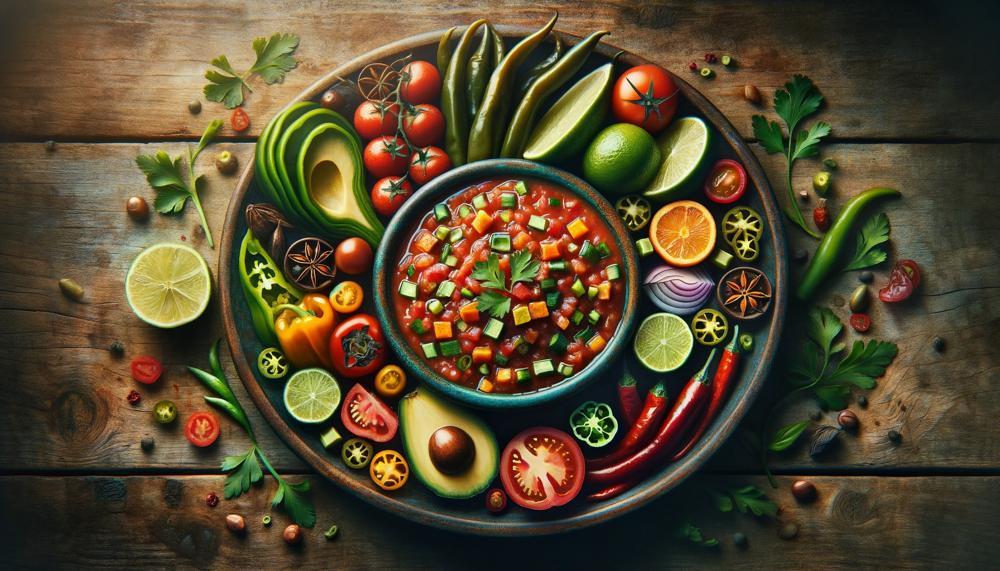Did you know that leaving salsa out for too long can put you at risk of food poisoning? Despite its delicious flavors and tempting presence at parties, salsa can quickly become a breeding ground for harmful bacteria if not properly stored.
In this article, I will explore the shelf life of salsa, the dangers of leaving it out, proper storage techniques, and more.
So, let’s dive in and ensure we’re enjoying our salsa safely!
Contents
Key Takeaways:
- Salsa should not be left out for more than two hours at room temperature to prevent bacteria growth and foodborne illnesses.
- Unopened store-bought salsa can last up to 18 months if stored properly, while homemade salsa has a shorter shelf life of 5-7 days.
- Always refrigerate salsa after opening and transfer it to an airtight container for maximum freshness.
- Freezing salsa can help extend its shelf life indefinitely, but be sure to use a freezer-safe container.
- Discard salsa if you notice an off odor, visible mold, or significant changes in color or texture.
The Shelf Life of Salsa

When it comes to salsa, both store-bought and homemade options have their own shelf lives. Understanding how long salsa can last is key to maintaining its freshness and ensuring food safety.
Store-Bought Salsa:
Unopened store-bought salsa can typically last between 12 to 18 months.
However, it’s crucial to always check the expiration date on the jar. The expiration date serves as a reliable indicator of the salsa’s freshness and quality.
Once opened, a jar of store-bought salsa will typically last for about 2 to 4 weeks when stored in the refrigerator.
Homemade Salsa:
Unlike store-bought salsa, homemade salsa has a shorter shelf life due to its fresh ingredients and lack of preservatives. Homemade salsa will stay good for only about 5 to 7 days when refrigerated. It’s important to consume it within this timeframe to avoid any risks of spoilage and foodborne illnesses.
Always be cautious and rely on your senses when consuming salsa. Keep an eye out for any signs of spoilage, such as mold growth, off odor, or significant changes in color or texture. If you notice any of these signs, it is best to discard the salsa to avoid any potential health risks.
Tip: To maximize the shelf life of salsa, it is essential to store it properly. Transfer any opened salsa to an airtight container before placing it in the refrigerator. This helps prevent any exposure to air and extends its freshness.
| Salsa Type | Unopened Shelf Life | Opened Shelf Life |
|---|---|---|
| Store-Bought Salsa | 12-18 months | 2-4 weeks |
| Homemade Salsa | N/A (consume within expiration date) | 5-7 days |
Can Salsa Be Left Out?
If you’ve already opened your salsa, it should not be left out on the counter. Fresh salsa can only remain safe for up to two hours at room temperature, or one hour if it’s over 90 degrees Fahrenheit.
Leaving salsa out for extended periods of time can lead to dangerous levels of bacteria growth and increase the risk of foodborne illnesses.
Proper Storage of Salsa
When it comes to storing salsa, proper refrigeration is key to maintaining its freshness and preventing mold growth.
Whether you have store-bought or homemade salsa, following these guidelines will help maximize its shelf life and ensure that it stays safe to consume.
Storing Unopened Salsa
If you have an unopened jar of salsa, the first step is to check how it was stored at the store. Some brands may need to be refrigerated, while others can be stored on the shelf until opened.
Always refer to the labeling instructions on the jar for the best storage recommendations. This will help maintain the salsa’s quality and prevent any potential spoilage before opening.
After Opening
After you’ve opened the salsa, it’s crucial to transfer it to an airtight container before refrigerating. This will help preserve its flavor and prevent any unwanted odors from seeping into the salsa.
Using an airtight container also minimizes the risk of contamination and keeps the salsa safe to consume over an extended period.
| Steps for Proper Storage of Salsa | Benefits |
|---|---|
| Transfer salsa to an airtight container | Preserve flavor and freshness |
| Place container in the coldest part of the fridge | Ensure optimal temperature for food safety |
| Close the container tightly | Prevent air exposure and mold growth |
Mold growth is a common concern when storing salsa. By ensuring that the salsa is properly sealed in an airtight container, you can significantly reduce the risk of mold growth. Mold not only affects the salsa’s quality but can also pose health risks if consumed.
Remember to store the salsa in the coldest part of the refrigerator, such as the back or bottom shelf, to maintain a consistently low temperature. Avoid placing it in the refrigerator door, as this area is prone to temperature fluctuations.
Following these storage practices will help extend the shelf life of your salsa, keeping it fresh and safe for longer periods. By taking these simple steps, you can enjoy your salsa without worrying about mold growth or compromised quality.
Freezing Salsa
If you have leftover salsa that you won’t be able to finish in time, freezing is a great option. Freezing salsa not only helps extend its shelf life but also maintains its flavor and texture for future use. Here’s how you can freeze salsa:
- Transfer the salsa to a plastic freezer bag. Make sure to remove as much air as possible from the bag before sealing it tightly.
- Label the bag with the date of freezing to keep track of its freshness.
- Place the bag of salsa in the freezer, ensuring it lies flat to maximize storage space.
By following these steps, you can keep salsa frozen for an extended period, allowing you to enjoy it at your convenience.
Signs of Spoiled Salsa
It’s important to be aware of the signs of spoiled salsa. If you notice a strange odor, visible mold, or a significant change in color or texture, it’s best to discard the salsa. Even if there are no obvious signs of spoilage, consuming expired salsa can still pose a risk of food poisoning. Always follow the expiration date and use your best judgment when deciding whether to consume salsa.
Conclusion
In conclusion, ensuring the safety of salsa is of utmost importance. While salsa can be left out for a short period, it is crucial to refrigerate it promptly to prevent the growth of harmful bacteria.
Proper storage and handling practices, such as refrigerating salsa after opening, can help extend its shelf life and minimize the risk of foodborne illnesses. Whether you have store-bought or homemade salsa, transferring it to an airtight container and storing it in the coldest part of the fridge is essential to maintain its freshness.
Additionally, being aware of the signs of spoiled salsa, such as off odors, mold, discoloration, and changes in texture, is vital in determining whether salsa is still safe to consume. Always adhere to the expiration date and use caution when consuming salsa, even if there are no visible signs of spoilage.
By following these salsa safety practices, you can enjoy your favorite dip without compromising your health. Remember to prioritize proper storage and handling to minimize the risk of foodborne illnesses and maintain the freshness of your salsa.
Source Links
- https://ask.metafilter.com/269222/Salsa-out-overnight
- https://pepperpalace.com/blogs/expert-tips/when-salsa-goes-bad-tips-for-keeping-salsa-fresh




